Related Research Articles

The Indonesian National Revolution, also known as the Indonesian War of Independence, was an armed conflict and diplomatic struggle between the Republic of Indonesia and the Dutch Empire and an internal social revolution during postwar and postcolonial Indonesia. It took place between Indonesia's declaration of independence in 1945 and the Netherlands' transfer of sovereignty over the Dutch East Indies to the Republic of the United States of Indonesia at the end of 1949.

The Royal Netherlands East Indies Army was the military force maintained by the Kingdom of the Netherlands in its colony of the Dutch East Indies, in areas that are now part of Indonesia. The KNIL's air arm was the Royal Netherlands East Indies Army Air Force. Elements of the Royal Netherlands Navy and Government Navy were also stationed in the Netherlands East Indies.

Koninklijke Nederlandsch-Indische Luchtvaart Maatschappij was the airline of the former Dutch East Indies. Headquartered in Amsterdam, KNILM was not a subsidiary of the better-known KLM, despite the similar name. The airline had its headquarters in Amsterdam and an office in on the grounds of Tjililitan Airfield in Batavia.
The Battle of Ambon occurred Ambon Island in the Dutch East Indies, as part of the Japanese offensive on the Dutch colony during World War II. In the face of a combined defense by Dutch and Australian troops, Japanese forces conquered the island and its strategic airfield in several days. In the aftermath of the fighting, a major massacre of many Dutch and Australian prisoners of war by the Imperial Japanese Army (IJA) followed. Following the war, many of the IJA personnel were tried for war crimes.
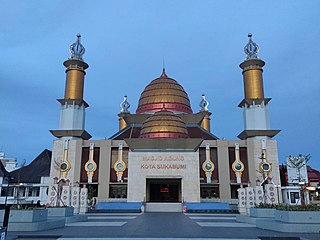
Sukabumi is a landlocked city surrounded by the regency of the same name in the southern foothills of Mount Gede, in West Java, Indonesia, about 100 km (62 mi) south of the national capital, Jakarta.
Bandung is a city in the western part of Java island in Indonesia. Beside its own city administration, Bandung also serves as the capital of the West Java province.

The Battle of Borneo was a successful campaign by Japanese Imperial forces for control of Borneo island and concentrated mainly on the subjugation of the Raj of Sarawak, Brunei, North Borneo, and the western part of Kalimantan that was part of the Dutch East Indies. The Japanese main unit for this mission was the 35th Infantry Brigade led by Major General Kiyotake Kawaguchi.
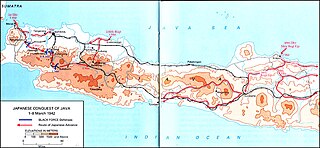
The Battle of Java was a battle of the Pacific theatre of World War II. It occurred on the island of Java from 28 February – 12 March 1942. It involved forces from the Empire of Japan, which invaded on 28 February 1942, and Allied personnel. Allied commanders signed a formal surrender at Japanese headquarters at Bandung on 12 March.
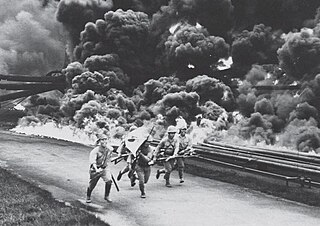
The First Battle of Balikpapan took place on 23–25 January 1942, off the major oil-producing town and port of Balikpapan, on Borneo, in the Netherlands East Indies. After capturing mostly-destroyed oilfields at Tarakan, Japanese forces send an ultimatum to the Dutch that they would be executed if they destroyed the oilfields there, to no avail.

General Simon Hendrik Spoor was the Chief of Staff of the Royal Netherlands East Indies Army and the Royal Dutch Army in the Dutch East Indies, from 1946 to 1949, during the Indonesian National Revolution.

Padalarang Station (PDL) is a railway station complex in Padalarang, West Bandung Regency, West Java, Indonesia. The complex is planned to serve long-distance train services from Kereta Api Indonesia, commuter trains from KAI Commuter, and Jakarta-Bandung high-speed trains from Kereta Cepat Indonesia China (KCIC). The complex is in the form of two different station buildings, each operated by KAI and KCIC, and connected via a pedestrian bridge.
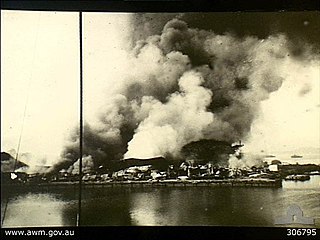
The Invasion of Sumatra was the assault by Imperial Japanese forces on the Dutch East Indies that took place from 14 February to 28 March 1942. The invasion was part of the Pacific War in South-East Asia during World War II and led to the capture of the island. The invasion of Sumatra was planned to occur prior to the invasion of Java to destroy the west flank of the allies and to give access to Java.

Bersiap is the name given by the Dutch to a violent and chaotic phase of the Indonesian National Revolution following the end of World War II. The Indonesian word bersiap means 'get ready' or 'be prepared'. The Bersiap period lasted from August 1945 to November 1947. In Indonesia, other terms aside from bersiap are commonly used, such as gedoran in Depok, ngeli in Banten and surrounding West Java, and gegeran and dombreng in Central Java.

Sultan Hamid II was the 7th Sultan of Pontianak and the only President of the State of West Kalimantan from 1946 to its disestablishment in 1950. He was the eldest son of Sultan Syarif Muhammad Alkadrie. He was of mixed Malay-Arab ancestry and was raised by two British nationals— Salome Catherine Fox and Edith Maud Curteis.
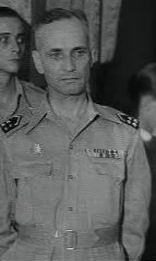
Major-general Dirk Reinhard Adelbert van Langen was a member of the Chief of Staff of the Royal Netherlands East Indies Army the Territorial Commander of East-Java and commander of the T brigade during the Indonesian War of Independence of the Royal Netherlands East Indies Army in the Dutch East Indies, from 1946 to 1949, during the Indonesian National Revolution.

The Battle of Tjiater Pass was a battle which occurred between 5 and 7 March 1942 during the Dutch East Indies campaign between invading Japanese forces and the Dutch colonial forces, supported by warplanes from the Royal Air Force. It was fought over control of the Tjiater Pass, as part of an attempted defense of the city of Bandung.

The Battle of Leuwiliang was a battle during the Dutch East Indies campaign of the Pacific War that took place between 3 and 5 March 1942. Australian forces, supported by American artillery batteries and British tanks, launched a holding action starting at Leuwiliang, West Java, to cover the retreat of allied Dutch forces in the face of the Japanese invasion of Java.

The Battle of Kalijati was a battle which occurred between 1 and 3 March 1942 during the Dutch East Indies campaign between invading Japanese forces and the Dutch colonial forces. It was fought over control of the Kalijati Airfield in Subang.
The Battle of Kendari took place on 24 January 1942 as part of the Japanese offensive in the Dutch East Indies. The airfield Kendari II at Kendari became an essential target for Japanese forces for its strategic location and infrastructure quality. Encountering little to no resistance, Japanese troops managed to capture the airfield in one day, as the Dutch defenders were already in retreat inland.

Major General Jacob Jan Pesman was a Dutch military officer during the Second World War. He was a commander in the KNIL colonial forces of the Dutch East Indies, and was the commander of one of its units during the Japanese invasion of Java.
References
- 1 2 3 4 Immerzeel, Bert (22 October 2010). "Politieschool onder vuur". JavaPost.nl (in Dutch). Retrieved 27 August 2022.
- 1 2 Jong, Loe de (1984). The Kingdom of the Netherlands During World War II: Volume 11a, Part 2 (PDF) (in Dutch). Leiden: Sdu. ISBN 9789012048996.
- 1 2 Immerzeel, Bert (1 March 2011). "Lou de Jong en het bombardement op Soekaboemi". JavaPost.nl (in Dutch). Retrieved 27 August 2022.